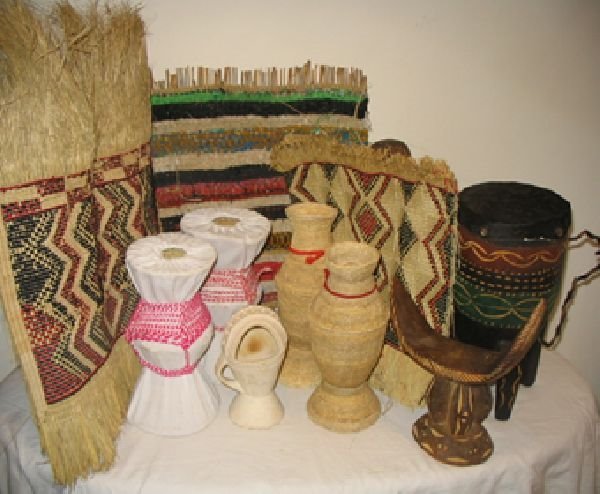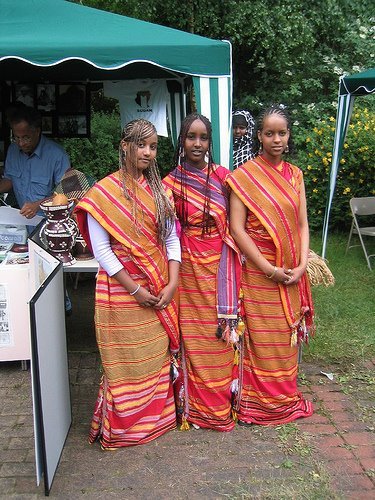
On the wall behind the woman is Salli or Derin. It is mainly used as a prayer mat, but it is also used to sleep on and sometimes it is spread out for the guests to sit on when they arrive. Notice that the man is sitting on one. The object on the wall where the man is leaning on is called Masarafad or sometimes called Masarafad Hilbood. Its main use was to take the large amounts of meat to the guests. The nomads often have many guests and huge quantities of meat is eaten. Receiving a guest with such generosity is often praise worthy and the theme of many verses of poetry. In the Somali culture, where families are judged by their hospitality, Sooryo (receiving guests well) is very important and so is Sagootin (seeing them off well). Now both these items are used for decoration purposes.

This woman is weaving baskets known as Dambiilo (single – Dambiil). Behind her on the wall is Kebed made from threads obtained from trees and strings. The object on her right handside with the blue and white patterns is called a Masaf or Xaarin and is used to separate soil and the impure particles from maize – a process called Haadin.

The mysterious containers (on the left) wrapped in a white cloth and laced by a red rope in the middle are called Xeedhooyin or a Xeedho for a single one and are carved out of wood. Though they are used to store food, they are also used mainly for wedding purposes and this is usually in the Northern regions. I will explain this in more detail in another post.
The other two similar containers (on the right) with the one single lace running across the top part are Dhiilo. This is just one of the many types of Dhiil and it is made from Caw. It is usually used in the Northern parts of Somalia.
Between these two sets of containers is a small object. This is called Dabqaad and is carved out of a special stone primarily found in Ceelbuur, in the South and many other Somali regions. It is used for burning Frankincense, Myrrh and other kinds of incense. The coloured object standing on the far wall facing you is called Alool, the other two facing each other are Kebdo(Single – kebed). They are all now used for decoration purposes. The Kebed is primarily used for building and a protection against the strong Jiilaal winds.

These brilliantly patterned objects are also Dhiilo (single – Dhiil). The object at the forefront, however, is not a Dhiil but a Mooyeand is used for grounding spices. These Dhiilo are used throughout Somalia but the methods of making them slightly differ in North and South. The ones above are carved out of wood and are particularly used in the Southern regions of Somalia.

This is the Dhiil used in the Central and Northern regions of Somalia. Notice the difference between the two. This Dhiil is made out of the Qabo tree and the thin fibres of the Booc tree which are then skilfully interwoven. Both types of Dhiilo are used for storing milk and water.

Whoever spent some of his childhood years in Somalia would automatically recognise this thing. It is called Garaangar and every child makes his own by hand. I remember running around all day behind my Garaangar knowing that I had the best toy in the world.

These are the traditional clothes worn by the Somali women. Known as Subeeciyad, it is a one single long cloth draped around the waist and over the shoulders.

The man you see above is being drenched in milk. A rather strange thing to be doing when you consider that that milk is much needed and many children sleep hungry at night. This is called Caana Shub and the man being treated in such a manner is the Sultan, Ugaas, Caaqil, Nabadoon, a sage or a leader of a certain tribe or region.

This is how older generations of Somalis dressed and kept their hair.

While travelling men usually carry a Barkin to rest their head on and keep their hair from touching the ground.

This is what a Somali spoon or a Fandhaal looks like. I am sure you can guess what its uses are. It is also carved out of wood.






